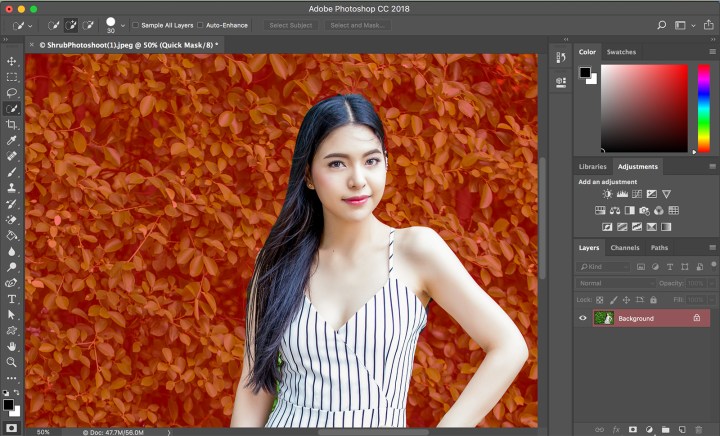
Photoshop 19.1
Previewed in November, Photoshop’s Select Subject is now an available feature. Powered by Adobe Sensei, the company’s AI platform, the tool is designed to select — in one click — what Adobe calls the “most prominent subject.” It uses computer vision to identify objects in the photo, then the software works to select just that subject.
Selecting an object in Photoshop is a technique used for a number of different types of edits, but is generally a time-consuming process. Select Subject is designed to jump-start that process, while photo editors can refine what the AI selected by using existing tools, like Select and Mask. In the preview of the feature, Adobe shared some well-selected images and others that were less than perfect. Jerry Harris, a Photoshop principal scientist, says the tool is designed to help get started on those selections faster. Of course, as the name suggests, the tool is only for selecting the subject of the image, not background objects.
The tool is available after updating to version 19.1, and navigating to the Select option in the menu bar and choosing “subject.” With the quick selection or Magic Wand tool selected, the top toolbar also houses a Select Subject option while a one-click button will also appear inside the Select and Mask window, offering a total of three places to find the new tool.

The new one-click selection option comes with an improvement inside the Select and Mask tool that will allow users to adjust that selection. Along with the existing tools, the selection editor now includes a decontaminate color slider. The slider was previously part of the Refine Edge tool, but Adobe switched to a simple checkbox when that tool was replaced with Select and Mask. Now, users can control the level of the decontamination, which helps refine the selection based on the colors along fine edges.
For Microsoft Surface Dial users, the latest update brings the option to adjust a number of brush assets. The change allows photo editors and graphic designers to control opacity, size, roundness, angle, scatter, texture depth, colors, opacity, flow, wetness, and mix, by changing the Dial settings accordingly. Adobe says the change allows users to adjust an element of the brush without pausing the actual brushwork.
The Dial compatibility comes alongside Windows High Density Monitor support, which will automatically adjust the user interface based on the monitor’s density. Adobe said the support was one of their top requests from Windows users and that the company worked alongside Microsoft on the new feature.
Adobe XD
Photoshop text copied and pasted into Adobe XD, Adobe’s software for designing user experiences, will also maintain its appearance with updated Scalable Vector Graphics (SVG) compatibility. The change comes as XD gains a number of compatibility enhancements for the design program.
The update enables XD to work alongside other prototyping tools, designed for speeding up the design process, including Zeplin, Avocode, Sympli, ProtoPie, and Kite Composer. Adobe says the third-party integrations are MacOS-only for now, but the company is asking Windows users for feedback on potential integrations for the future. Third-party integrations also now allow for XD previews to display inside of Dropbox, allowing for a glance at the file before downloading.
Along with the new integrations, XD has a few new tools of its own, including a new radial gradient tool, batch exporting and support for all three HEX, RGB and HSB color profiles. A performance boost allows for faster zooms on bigger files, Adobe says. The update also includes improvements to Design Specs, which remains in beta.
Editors' Recommendations
- You can finally use Adobe’s game-changing AI features in Photoshop, Premiere, and After Effects
- 5 amazing AI features in Photoshop you can use now
- Adobe adds AI magic to Photoshop and Premiere Elements
- What is Photoshop Camera? How Adobe’s new A.I. app edits photos before you take them
- Photoshop just turned 30. So what’s coming in the next three decades?





